6-7-25
Nora’s Greater Good: A Doll’s House Part 2 (and 1)
By Diane Sippl
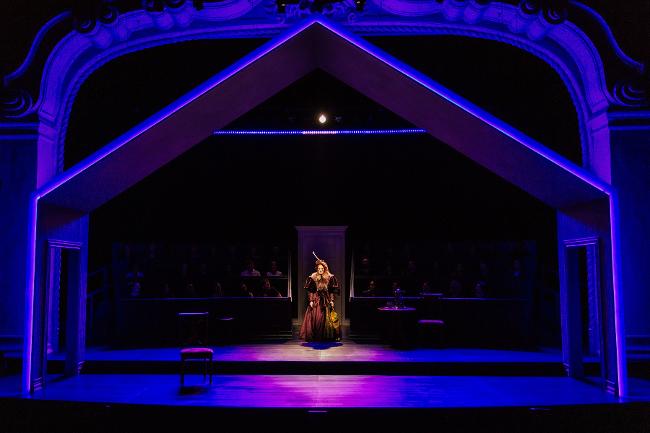
To celebrate its 100th birthday and also the oncc-again ownership of its landmark theatre complex, Pasadena Playhouse has brought Lucas Hnath’s Broadway success back to Southern California this spring (it first opened at South Coast Repertory in Costa Mesa in 2017). Hnath’s A Doll’s House Part 2 commences 15 years after Ibsen’s Nora walked out the door of her home and family. With freshly impressive actors and audience seating that includes the stage for the look of an updated Greek chorus, the new play’s style offers slight touches of our century (in dialogue, costumes, hairstyles) for a script deeply immersed in Henrik Ibsen’s 1879 original, so much so that it’s worth taking a backward glance at what might not seem like so long ago…
He is the writer of angst-ridden plays set in suffocating Nordic rooms where the only relief – and relief it never is – is a view of a brooding fjord….
Andrew Dickson, “Ibsen, the Unlikely Radical” in Barbican
THE TWO PIONEERS
That is, pioneers of the march to the plains of heaven (so to speak).
The second, whose eyes are in the back of his head, is the man who declares that it is wrong to do something that no one has hitherto seen any harm in.
The first, whose eyes are very longsighted and in the usual place, is the man who declares that it is right to do something hitherto regarded as infamous.
The second is treated with great respect by the army. They give him testimonials; name him the good man; and hate him like the devil.
The first is stoned and shrieked at by the whole army. They call him all manner of opprobrious names; grudge him his bare bread and water; and secretly adore him as their savior from utter despair.
George Bernard Shaw, “Ideals and Idealists,” The Quintessence of Ibsenism
“Peer, you’re lying,” were the words that opened Henrik Ibsen’s break-out play, Peer Gynt, in 1867, and they couldn’t have been more telling of his entire oeuvre for the rest of that century. From little white lies to outright mendacity, from forgery and fraud to ideological fallacy, from blind delusion to willing disbelief, from social hypocrisy to self-deception—all of these, whether actions, stances, lapses, or irremediable traits, would fester in the bard’s emotional stockpile until he could release them meaningfully into his next opus. Characters strong yet unprincipled—schooled in the maneuvers of evasion and compromise only to uphold hollow ideals—filled his stages with heroics that stood false beside humble humanity. Sprouting in a garden soil of social tensions, individual vanity pre-empted the development and growth of intimate relationships and supplanted them with manipulation. What better case study than A Doll’s House, having been written from self-exile in Germany, but soon to become Ibsen’s most performed play of them all, once he became (in)famous for dismantling the sanctity of marriage and the family by letting his heroine walk out the door.
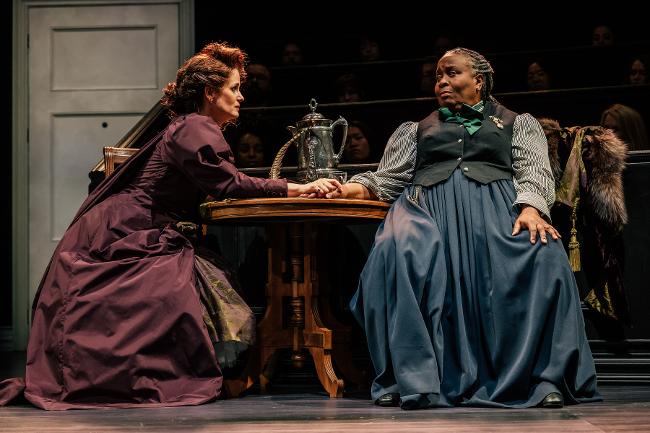
An anarchist’s pistol shot could not have reverberated more frighteningly in the Victorian world than the closing of that door.
John Gassner, American drama critic, 1958
Of course, the question remains: what, exactly, was so exhilarating about Nora’s exit that it ushered into the Western world Ibsen’s more long-standing reputation as the father of modern drama? Let’s recall the architecture of Nora’s “little doll house,” as she calls it, built on a solid foundation of the everyday idealist morality of the middle class in late 1870’s Norway.
Torvald Helmer, the owner of the house (and of the “doll,” practically speaking), is a model husband, father, and citizen, and Nora believes that just as she upholds the ideal role of wife and mother (a second-class member of the society confined to her duties within the home), her spouse would give his life to save her reputation. (This, after all, was the “gentleman’s agreement” then and long thereafter.) Torvald is rising in the community as a prominent banker, but earlier on he was struck with an illness requiring care abroad for which he couldn’t pay and couldn’t admit falling short, being a “manly man.” Nora devotedly but secretly paid for the trip with funds from a money lender, her father being required to endorse the promissory note. Yet he himself died before he could sign, so Nora, determined to save Torvald, forged her father’s name. Torvald recovered and rose in social prominence, while Nora, possessed of not only initiative and courage, also slaved as a scrivener to pay off nearly all of her debt. BUT now the money lender needs a favor. Knowing that Nora forged the paperwork, he’s not afraid to resort to blackmail when he needs his job at Torvald’s bank restored to him (he was fired due to his own past forgery). Still in the dark about the whole ordeal, Torvald denounces forgers and the “bad mothers” that raise them, and Nora comes to feel not only criminal and unworthy as a role model, but also naïve about the ways of the world. When she uses her feminine wiles to borrow money from a male friend to pay off the last bit of the loan, she further comes to feel like a sex object and reflects on her prescribed role as her husband’s “doll.” A letter appears.
In another play, Torvald’s discovery of Nora’s deception would be the turning point. Instead it comes with the upheaval of Nora’s two prevailing assumptions: that marriage would protect her from harm and that her husband would sacrifice anything for her. She is ready to die for him to save his reputation, expecting that, should the need arise, he would take on her crime to protect her. Instead he torments her for disgracing him, raging to the point that all her illusions about her home crumble. In fact, the blackmailer withdraws his threat and her husband is ready to embrace Nora and a “normal, respectable” life again. He pleads that she remain at home to avoid a scandal. Yet she has already reached a point of no return, and she walks out the door to discover the real world, to build a position of integrity, to become a better role model, and to seek an honorable relationship.
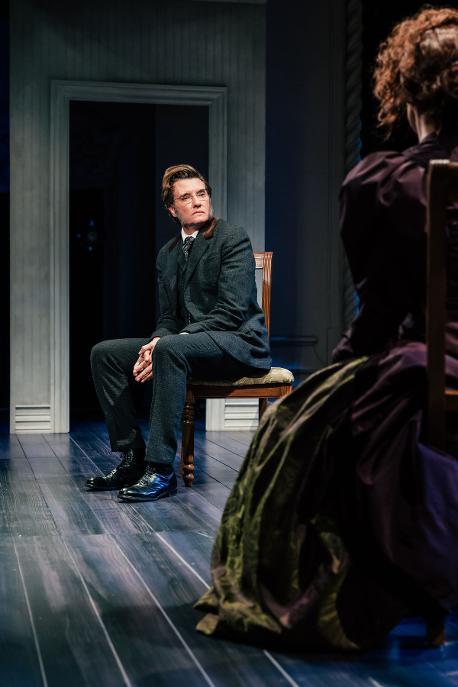
It’s worth noting that preceding Nora’s retreat from home and family, she arrives downstairs to Ibsen’s “talk table” center stage with Torvald’s blandishments of her performance moments earlier of the Tarantella (an ecstatic trance dance of southern Italy, allegedly a therapy for tarantula bite victims—and later, neurotic women). His “capricious little Capri maiden” was entertaining their guests, and he had to pull her away by gentlemanly “force” because her dancing was “too realistic”—thus “incompatible with the limitations of the art” (more to the point, his “blood was on fire” and he couldn’t endure such a state of desire any longer)—and also because she is “self-willed” (despite the fact that as her husband, he is entitled to her body). Of course, we haven’t seen her dance, but the dialog lays the ground for the argument to come. Once Torvald bids good night to Nora’s friend Mrs. Linde by demonstrating that her choice of knitting is clumsy and unbecoming, that embroidering would be so much more graceful and charming, the remainder of Act III (and the play) becomes Nora’s rebuttal to his blatant chauvinism.
No longer passive, accommodating, and cajoling, Nora surprises us. When Torvald asks her if she understands “what she has done” (alluding to the forgery), she replies by taking the words as a double entendre: “Yes, now I am beginning to understand thoroughly,” referring not so much to her self-sacrificing act but to her entire married life as his “little skylark.” Immediately following her inner thoughts of suicide to protect his reputation, he lashes out at her as a “hypocrite, a liar, and worse, worse—a criminal,” bringing shame for the “unutterable ugliness of it all!” And this is when Ibsen’s innovation as a dramatist takes off.
Initially Torvald would have resolved the dilemma by finagling some kind of compromise with the blackmailer, confining Nora to the house, and forbidding her to raise the children. No one in the community would be wise to the crime and how it humiliated Torvald. Yet when a second letter arrives, canceling the threat, and Torvald rejoices, “I am saved!”, he professes endless pride for forgiving Nora:
Do you suppose you are any less dear to me, because you don’t understand how to act on your own responsibility? No, no; only lean on me; I will advise you and direct you. I should not be a man if this womanly helplessness did not just give you a double attractiveness in my eyes…. There is something so indescribably sweet and satisfying, to a man, in the knowledge that he has forgiven his wife… It seems as if that had made her, as it were, doubly his own; he has given her a new life, so to speak; and she has in a way become both wife and child to him. So you shall be for me after this, my little scared, helpless darling…. I will serve as will and conscience both to you—

Meanwhile Nora has gone up and changed and returned to insist that Torvald sit down to hear her “settling of accounts.” In eight years of marriage, they have never understood each other, never sat down together to get to the bottom of anything; he has never loved her but only enjoyed the pleasantry of being in love with her; she has learned to adopt his taste and exists merely to perform tricks for him, so she has made nothing of her own life. What’s worse, religion, morals, the law—these are all quite something else than what she supposed them to be. If a woman has no right to spare her father on his deathbed or save her husband’s life, then she must stand alone, learn, and discover who is right, the world or her. And then come her clear and simple words: “I do not love you anymore.”
And what has he done to forfeit her love? That very night, the “wonderful thing” did not happen: Torvald did not stand up to the blackmailer in defiance and ultimately take on the guilt himself. “No man would sacrifice his honor for the one he loves,” insists Torvald, only for Nora to reply, “It is a thing hundreds of thousands of women have done.”
These two lines highlight the consummation of Ibsen’s highest achievement in A Doll’s House: the intense and prolonged discussion of ideas, a dramatic strategy and superbly executed technique that delivered the revolution of realism to the European stage. Yes, Nora flat-out rejected the role of the “womanly woman” that playwright George Bernard Shaw would so eloquently identify in his 1891 classic, The Quintessence of Ibsenism; instead she became the “first pioneer” of his clearly delineated leaders, inspiring the likes of painter Marie Bashkirtseff, whose shocking 1890 diary prompted the Irish polemicist’s staunch and indispensable critique of marriage and the family in his homage to Ibsen. One who has surely studied Shaw’s treatise is none other than American playwright Lucas Hnath, who doesn’t miss a beat of Shaw’s argument in writing his own homage, A Doll’s House Part 2.
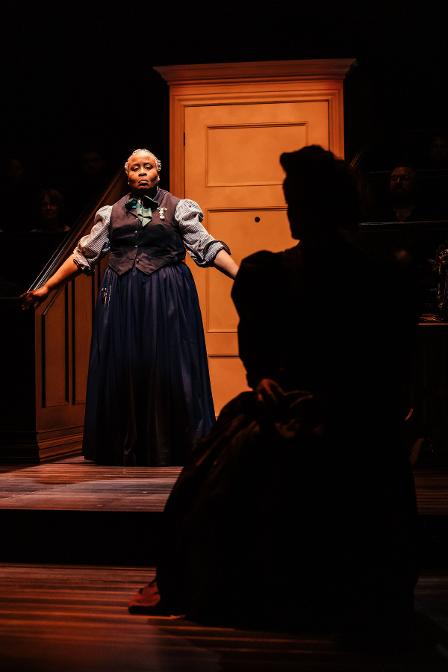
You can’t speak to a caterpillar in the language of a butterfly.
Anonymous
It would seem that today, nearly 150 years after Nora left the home for the world, our fascination with A Doll’s House Part 2 by Lucas Hnath would reside in how vastly different it must be from Ibsen’s original, written in 1879—different in conflicts and ideas, and different in form and style. Yet what is even more fascinating is how similar the two plays are, and the ways and the reasons.
True enough, in Hnath’s play, 15 years after her life with Torvald, Nora is newly confident, even a bit feisty, in sharing the ideas she has discovered and developed as an independent woman and even expressed as an evolving writer. Yet crucially significant, as the play opens, she is as resourceful as ever in harnessing the skills with which she was raised—ingenuity and persuasion. The fact is, she is in need—not of money or a home or a man (God forbid—she has experienced a number of them since she left, with little satisfaction)—but of confirmation of her divorce from Torvald. Blackmail surfaces as a driving action (or threat of one) in Part 2 just as it did in Part 1. Nora would like to avoid it by securing her papers, simple as that—or is it? Torvald has proceeded to live as if she is dead (her parting words in Part 1 were that he was a stranger to her); that way he could avoid the daily shame of having been “left.” Nora has to find a way to get what she needs from him, and her old nanny, Anne Marie, and her daughter, Emmy, are of no help. Anne Marie resents her for having burdened her with raising the abandoned children, not to mention looking after Torvald, who was a train wreck after Nora’s abrupt departure, but who has continued to take care of Anne Marie just as she has looked after him. The grown-up Emmy, feeling duly estranged from her mother, wants to avoid all scandal so as to be the “womanly woman” her banker fiancé would desire. No one has ears for Nora’s diatribes against marriage and her peculiar vision of women as free agents in the world of men. Particularly not Torvald. He is hurt, humbled, and angry—after all, having an epiphany and walking out was easy for her; staying and working it out would have been harder. Most of all, he is sad—that “the wonderful thing” (her “love,” as he sees it) never happened for him and Nora.
All of this conflict, of course, to deserve the name A Doll’s House Part 2, requires more than melodrama, or even family drama as we know it in the 21st century. This homage to Ibsen is updated, to be sure—but mostly to 15 years later, the 1890s. Wild hair and a pair of sneakers under a bustled floor-length dress might remind us of how relevant the issues are today, and jaunty-profane language now and then lets us feel familiar with the characters even when the particular slang is out-of-character, but on the extremely minimal set with only four actors, the swiftly-paced dramedy flies by and yields to a psychological study and a theatre of ideas: who is Nora, and where does she “get off”?
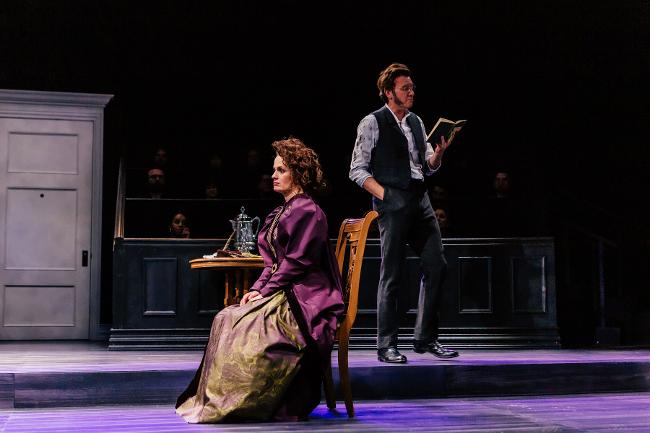
In a brisk, no-intermission play without separate acts and scenes and sets—in fact, very little action—the drama simply rotates according to characters. Talky as they are, they often deliver endless monologues, especially Nora, who launches the contest of ideas by arguing to Anne Marie that marriage “is cruel and destroys women’s lives.” So-called “love” becomes ownership; the people we choose change—indeed marriage itself changes them for the worse; the wooing of courtship becomes heedless selfishness after the nuptial contract; we naturally stray and then beat ourselves up for failing to be who we never were in the first place. This is what Nora has written and published, under a pseudonym that gets revealed by an angry judge whose wife has left him due to Nora’s literary influence. Her real name is still Mrs. Nora Helmer, so Torvald is entitled to all the money she has earned, and her contracts, business, and lovers have all been against the law, since married women are not allowed to engage in these activities without the consent of their husbands. The judge can send her to prison unless she retracts her whole critique and apologizes for it. Nora would fight back with her divorce and prove the judge wrong, but she has no power to initiate it. All Torvald has to do is sign the papers, and it’s a done deal. There’s another problem, though: all the opportunities for fraud and forgery that Nora left behind have reared their ugly heads in the household once again.
In Lucas Hnath’s A Doll’s House Part 2, Nora has, through much strife, found her own voice and written her own story, much to the chagrin of Torvald, who has read it and must reckon with a deeper assault and more profound heartache than when she said good-bye. For one thing, now the whole world can read her torment (albeit, under Nora’s pseudonym), and now, thanks to his new heroics, he must face his own 15 years of public deception and a daughter he raised who is willing to perform the same crime of which he accused her mother, and for the same reason—to save him.
The ironies in the last two scenes of the play, labeled “Emmy” and “Nora & Torvald,” are ingenious in responding to and extending Ibsen’s masterwork—so much so that getting caught up in their wind in sailing through the storm, it’s possible to lose sight of the way Hnath pulls it off. As earlier and throughout the drama, Hnath structures it as a series of forums—two-party dialogues between domestic jousters. He models them on Socrates and Shaw, colloquial as they are in their modern language—that is, he is aggressively confrontational when it comes to ideas (call them ideals and conventions). He knows the battleground of points of view, and we are hard-pressed not to understand both sides.
There is a lot of Ibsen in Nora, and there is a lot of Ibsen in Hnath. Ibsen was surrounded by a powerhouse of female role models in his mother, her female friend, his own wife, and his mother-in-law. Yet having himself grown up with a father who brought the family social shame and economic hardship, Ibsen felt first-hand the conventions of the community and its scorn. As a teenager, he fathered a child with the family’s domestic worker in her 30s, and while he was required to make support payments and did, he never owned up to the son publicly and lived in self-exile abroad for most of his career while the son perished as an alcoholic and his mother went blind and died.
Lucas Hnath grew up for much of his life with a single mother in Florida, but his absent father did support him economically by sending him to private schools (Hnath even took a whole college course on “Marriage”). He was raised with religion: his mother was active in the local church, and he became an avid student of the doctrines and sermons. More important, he tuned his ear to the rhythms and cadences of oral speech, the importance of pacing, and the power of the vernacular. If Ibsen grounded him in arguing ideas as Shaw did in whip-smart banter and provocation, Hnath developed a grammar of his own—the full-sail movement of words through the deployment of enjambments without pause, ellipses (“for thinking or re-thinking or sussing or a look, a sidelong glance”), dashes for fragments to “move through without air” and slashes for lines that cut in without stopping. In sum, Hnath’s verbal forums bring Ibsen to Shaw’s world (around 1894, when Nora returns “home”) and to our world today with merit, heft, and ballast, and that ship sails straight to the discussion of “the wonderful thing” that Nora and Torvald never shared. Maybe in the next play… but will Nora live to see it?
A Doll’s House Part 2
Pasadena Playhouse
May 14-June 8, 2025
Writer: Lucas Hnath; Director: Jennifer Chang; Scenic Design: Wilson Chin; Costume Design: Anthony Gran; Lighting Design: Elizabeth Harper; Sound Design: John Nobori
Cast: Elizabeth Reaser, Jason Butler Harner, Kimberly Scott, Kahyun Kim
Photos by J. Lorch